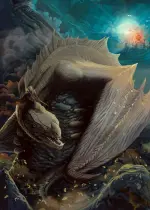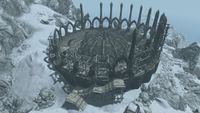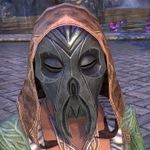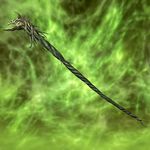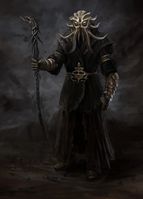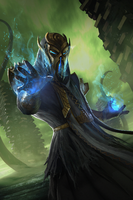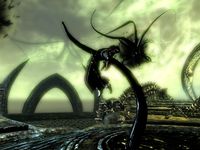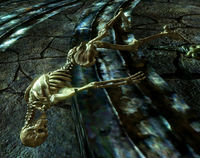Lore:Miraak
| Miraak | |||
|---|---|---|---|
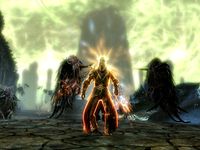 Miraak as seen in Dragonborn
Miraak as seen in Dragonborn |
|||
| Race | Proto‑Nord† | Gender | Male |
| Born | Merethic Era |
||
| Died | 4E 201 Apocrypha |
||
| Resided in | Solstheim Apocrypha |
||
| Appears in | Dragonborn, Legends | ||
- Here in his shrine, that they have forgotten. Here do we toil, that we might remember. By night we reclaim, what by day was stolen. Far from ourselves, he grows ever near to us. Our eyes once were blinded, now through him do we see. Our hands once were idle, now through them does he speak. And when the world shall listen, and when the world shall see, and when the world remembers, that world will cease to be. - Miraak's Chant[1]
Miraak (meaning Allegiance Guide in the dragon language), also known as the First Servant,[2] was originally a Dragon Priest in the Merethic Era. He is the First Dragonborn,[1] although that term would not become used until after the time of St. Alessia, the first Dragonborn recorded in history.[1][3] He ruled over the island of Solstheim, where a large temple was dedicated to him.[1]
Contents
Biography[edit]
He served as a leader of the Dragon Cult[4] and possessed a Dragon Priest Mask called Miraak, given to him by the dragons. At some point, he sought out the teachings of Hermaeus Mora, the Demon of Knowledge, and became his champion. Hermaeus Mora taught Miraak the power to bend the will of dragons.[1][5] Using this knowledge and his innate ability to devour the souls of dragonkind, he turned on his winged overlords and killed a great number of them.[1] Three Dragon Priests, Ahzidal, Dukaan and Zahkriisos, joined him and became his three most powerful servants, called the "Acolyte Priests".[6]
During the Dragon War, Hakon One-Eye and others sought him out, desperate for a strong ally in their fight against Alduin. Miraak, though apparently confident that he could defeat Alduin if he so chose, refused to help, leaving mankind to their own fate.[7]
Skaal legend remembers Miraak as "the Traitor", and recounts how he plotted against the dragons with Hermaeus Mora. Another Dragon Priest, Vahlok the Jailor (known as "the Guardian" to the native Skaal), uncovered this deception, and the two engaged in a duel so vicious and destructive that the modern island of Solstheim was allegedly ripped from the mainland of Skyrim.[8][9] Vahlok defeated Miraak, but just as he prepared to deliver the killing blow, Hermaeus Mora snatched away and saved his champion.[8] Following this, the dragons razed his temple to ashes,[10] and tasked Vahlok the duty of watching Solstheim for signs of Miraak's return.
Miraak was not seen or heard from again for many ages;[8] he evidently spent all of this time in Apocrypha, Hermaeus Mora's realm. Though he essentially became imprisoned there, Miraak spent his time gathering knowledge and power with the goal of freeing himself from Hermaeus Mora's service.[7]
Some time during the Second Era, Miraak tricked one of Hermaeus Mora’s Ciphers into smuggling cursed scrolls into the scriptorium Quires Wind. The scrolls caused many of the Ciphers to turn into Hushed and the scriptorium’s Daedric guardians to go mad and feral.[11]
It wasn't until 4E 201 that Miraak was able to use arcane magical powers to overtly influence the people of Solstheim, making them unknowingly work for him around the island, such as by rebuilding his temple, while they slept. They also worked on building arches around the Stones of Power on the island, which were apparently meant to assist in his return by harnessing the energy of the stones. Others came to worship Miraak more consciously, and formed a cult dedicated to him.[1]
Miraak's plan became threatened by the advent of the Last Dragonborn, and cultists were sent to track down and kill this "False Dragonborn".[12] The Last Dragonborn responded to this antagonism by journeying to Solstheim, where the hero sought out and used the hidden knowledge of Hermaeus Mora to thwart Miraak's efforts on Tamriel, journey into Apocrypha, and confront him in battle. When it was clear that Miraak would lose, Mora dealt him a fatal blow, killing the First Dragonborn and allowing the Last Dragonborn to claim his soul.[1]
Artifacts[edit]
Mask[edit]
Prior to his betrayal of his Dragon overlords, they had granted Miraak a mask that had the ability to significantly fortify the wearer's magicka. The mask bears a striking resemblence to the so-called "Tusked Dragon Priest Mask", though with the addition of tentacle-like motifs.
Firstblade[edit]
Firstblade, also known as Miraak's Sword, is a powerful sword linked to Apocrypha. It appears as a primal green blade with writhing sclerotic watcher tentacles and Seeker-sinew Threads wrapped around it, which extend to attack targets and drain their stamina during combat. When it is swung it takes the shape of a tentacle and grows in length, and even when not being swung, the sword writhes with tentacles around it, with them parting around the base of the sword to expose a green eye. It can be tempered with the use of ebony and daedra hearts, much like other Daedric weapons.
It is unknown if Firstblade was seen after the Merethic Era, but by the Second Era the Skaal of Solstheim knew it as a strange sword that belonged to a renegade Dragon Priest named Miraak far in the distant past. The sword was in possession of the renegade dragon priest Miraak, perhaps dating back to the time before the Dragon War, and was in his possession during his time in Apocrypha. In 4E 201, he used the sword while battling the Last Dragonborn at the summit of Apocrypha, who killed him and took possession of the blade.
Miraak's Staff[edit]
Miraak's Staff is a staff capable of spewing forth writhing apocryphal tentacles, staggering and poisoning those who they touch.
Gallery[edit]
Notes[edit]
See Also[edit]
References[edit]
- ^ a b c d e f g h Events of Skyrim: Dragonborn
- ^ Cipher Agrushna's dialogue in ESO: Necrom
- ^ The Book of the Dragonborn — Prior Emelene Madrine
- ^ Firstblade Style bundle description in ESO
- ^ Hermaeus Mora's dialogue in Skyrim: Dragonborn
- ^ The Elder Scrolls V: Skyrim: Prima Official Game Guide
- ^ a b Miraak's dialogue in Skyrim: Dragonborn
- ^ a b c The Guardian and the Traitor — Lucius Gallus
- ^ Tharstan's dialogue in Skyrim: Dragonborn
- ^ Frea's dialogue in Skyrim: Dragonborn
- ^ Cipher Sabinius's Apology — Cipher Sabinius
- ^ Cultists' Orders
- ^ Paarthrunax's dialogue in Skyrim
- ^ First Servant's Letter, Page 2 — The First Servant
- ^ The Origin of Cyrus! — Michael Kirkbride
- ^ Frontier, Conquest — University of Gwylim Press, 3E 344
- ^ The Improved Emperor's Guide to Tamriel: Skyrim — Flaccus Terentius, 2E 581
- ^ High King Sunstone antiquity codex entry in ESO
